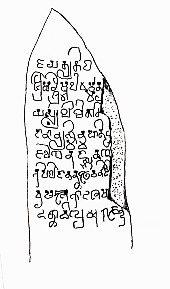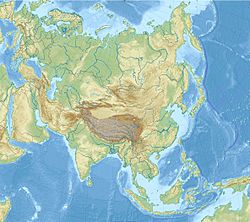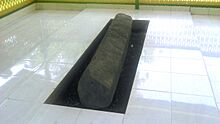Kutai facts for kids
Kutai is a special historical area in East Kalimantan, Indonesia. It's located on the big island of Borneo. The name "Kutai" also refers to the local people who live there, called Urang Kutai. There are about 300,000 Kutai people, and they have their own language called Kutainese language.
Today, the name Kutai is used for three areas in East Kalimantan: Kutai Kartanegara Regency, West Kutai Regency, and East Kutai Regency. The important Mahakam River flows through the heart of this region. Kutai is famous for being the home of the first and oldest Hindu kingdom in the East Indies, called the Kutai Martadipura Kingdom. Later, a Muslim kingdom, the Kutai Kartanegara Sultanate, took its place.
Contents
Ancient Kingdoms of Kutai
Throughout history, two main kingdoms ruled the Kutai region:
- Kutai Martadipura Kingdom (399–1635): This was a Hindu kingdom.
- Kutai Kartanegara Sultanate (1300–1844): This was a Muslim kingdom.
The Hindu Kutai Martadipura Kingdom


The Kutai Martadipura Kingdom was a Hindu kingdom that started around the 4th century AD. It was located in the Kutai area of East Kalimantan. Many historians believe it was one of the very first ancient kingdoms in Indonesian history.
Its capital city was likely in the area now known as Muara Kaman district. This is proven by an old stone called Lesong Batu. People believe this stone was used to make the famous Yupa inscriptions.
The Yupa Inscriptions
Seven stone pillars, called yūpas, were found near the Mahakam River. These pillars have writings in the Pallava script from India. The writings are in Sanskrit and say, "A gift to the Brahmin priests." Experts believe the writing style dates back to the late 4th century.
It's thought that Hinduism and other religions came to Indonesia around the 2nd to 4th centuries. This happened when traders from India arrived on islands like Sumatra, Java, and Sulawesi.
The Kings of Kutai Martadipura
We know the names of three rulers from these inscriptions:
- Kuḍungga: He was called the "lord of men."
- Aśwawarman: Kuḍungga's son, known as the "founder of the dynasty."
- Mulavarman: Aśwawarman's son, called the "lord of kings."
The name "Kuṇḍungga" doesn't sound like a Hindu name. This makes some people think he was a local leader, perhaps from the Dayak people. His son, Aśwawarman, might have been the first to truly adopt Hindu beliefs.
King Mūlawarman was the one who ordered the Yūpa inscriptions to be made. These were likely created by the Brahmins who received gifts from him. Mūlawarman was also known for winning battles against his neighbors. He even performed a special Vedic ritual called "Asvaredjwa" to expand his kingdom. This ritual involved releasing a horse, and any land the horse walked on became part of his kingdom.
The Lesong Batu Stone
The Lesong Batu is a large stone found in Muara Kaman district. It is believed to be a tool used to create the ancient Yupa inscriptions during the 4th century AD. It's a key piece of evidence from the Kutai Martadipura kingdom.
The Muslim Kutai Kartanegara Sultanate
The Kutai Kartanegara Sultanate began around the end of the 13th century AD. It was located in an area called Tepian Batu or Kutai Lama. The first known ruler was Aji Batara Agung Dewa Sakti, who ruled from 1300 to 1325.
Later, a ruler named Aji Pangeran Sinum Panji Mendapa (who ruled from 1635 to 1650) was able to conquer the older Kutai Martadipura Kingdom. He combined the two kingdoms, creating the "Kutai Kartanegara Ing Martadipura."
In 1667, the Dutch V.O.C. attacked Makassar on the island of Sulawesi. This led to the fall of the Bugis Kingdom of Gowa. Some Bugis people, led by Lamohang Daeng Mangkona, moved to Kutai on Borneo. The ruler of Kutai allowed them to settle along the Karang Mumus River. This settlement eventually grew into the modern city of Samarinda.
Islam became important in the region starting in the 17th century, partly because many Bugis people were Muslims. Aji Muhammad Idris, who ruled around 1732–1739, was the first ruler to have an Islamic name.
After a conflict, Aji Imbut became the ruler in 1780, taking the name Aji Muhammad Muslihuddin. He moved the capital city in 1782 from Pemarangan to Tepian Pandan. This capital city eventually became known as Tenggarong.
In 1844, the Dutch took control of Kutai after defeating Sultan Aji Muhammad Salehudin. The Sultan was forced to leave, and the Dutch ruled directly.
During World War II, the Japanese invaded the region in 1942. They recognized a "Kooti Kingdom" that was under their control. In 1945, Kutai joined with its neighbors to form the East Kalimantan federation. Finally, in 1949, Kutai became part of the United States of Indonesia.
Kutai Governance Today
On October 4, 1999, the area that used to be the Kutai Kartanegara Sultanate was divided. It became the Kutai Kartanegara Regency, East Kutai Regency, West Kutai Regency, and the city of Bontang. Later, in 2012, parts of West Kutai Regency became a new area called Mahakam Ulu Regency.
Each of these areas is led by a local leader called a Bupati. They are all part of the East Kalimantan Province. The position of Sultan of Kutai Kartanegara still exists, and the Sultan lives in the Kutai Palace in Tenggarong. However, the government is now run by the Republic of Indonesia, not the Sultanate. The Sultan has an honorary role and is highly respected by the Kutai people. During the Erau festival, the Sultan is an honored guest, along with government officials.
The Kutai People

The Kutai people, also known as Urang Kutai, are an ethnic group whose ancestors are believed to be descendants of the Dayak Ot Danum people. They have adopted Islam and mostly live along the banks of the great Mahakam River in East Kalimantan. They are native to the city of Tenggarong and the areas of Kutai Kartanegara Regency, West Kutai Regency, and East Kutai Regency.
The Kutai Language
The traditional language of the region is called Tenggarong Kutainese language (Bahasa Kutai Tenggarong). It is related to other languages spoken in coastal East Borneo, like Banjarese and Beraunese. This language belongs to the large Austronesian family of languages.
Images for kids
-
Tingkilan, the traditional music of the Kutai people
See also
- Kutai Kartanegara Regency
- Kutai National Park







